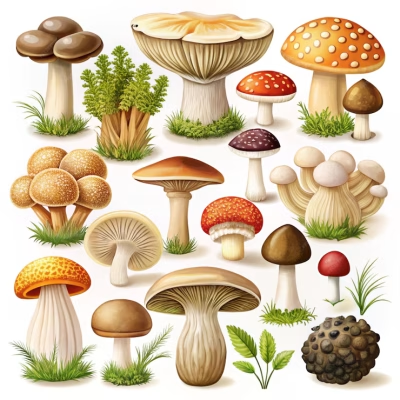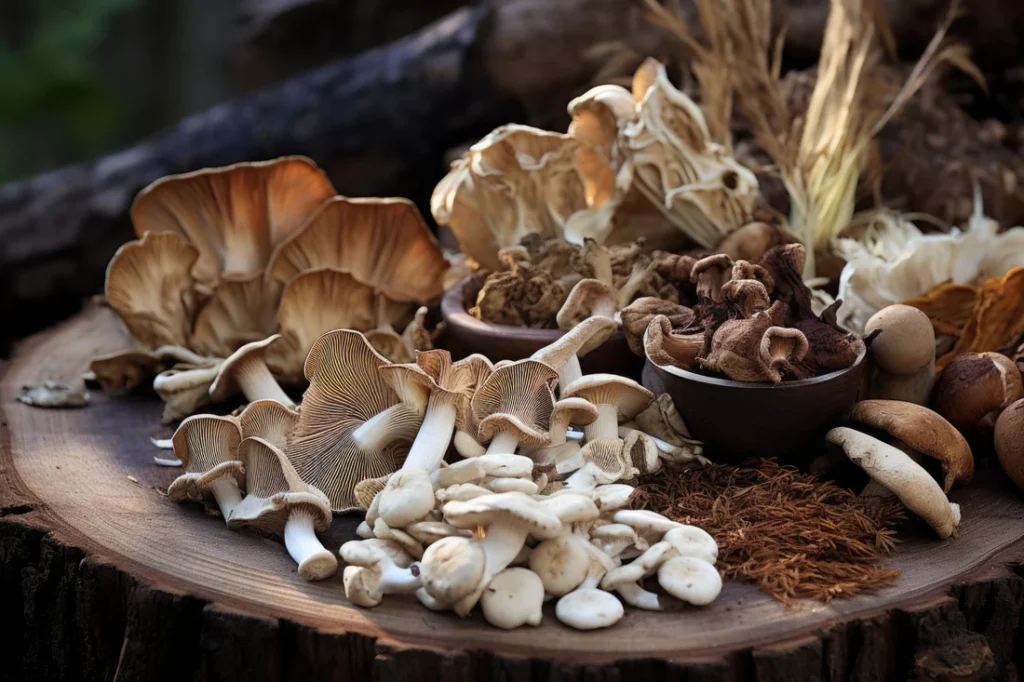The Boon and Bane of Mushrooms
Mushrooms, often viewed simply as culinary ingredients, hold a multifaceted role in human culture, health, and the environment. As interest in mushrooms surges, particularly for their culinary, nutritional, and medicinal benefits, it’s essential to explore both the positive impacts (the boom) and the potential drawbacks (the bane) associated with their use.
This exploration reveals a complex relationship between humans and these fascinating fungi, highlighting both their promise and challenges.

The Boon of Mushrooms
- Ecological Importance
Mushrooms are integral to ecosystems. As decomposers, they break down organic matter, recycling nutrients back into the soil. This process is crucial for maintaining soil health and supporting plant growth. Mycorrhizal fungi, which form symbiotic relationships with plant roots, enhance nutrient uptake, particularly phosphorus, thereby promoting plant health and biodiversity.
Furthermore, mushrooms can help combat environmental issues. Some species can degrade pollutants, including heavy metals and pesticides, through a process called mycoremediation. This ability makes them valuable allies in efforts to clean contaminated environments.
- Culinary Uses
In the culinary world, mushrooms are celebrated for their diverse flavors, textures, and nutritional benefits. Varieties such as shiitake, portobello, and oyster mushrooms are not only delicious but also versatile, appearing in a multitude of dishes ranging from soups and salads to stir-fries and pasta.
Nutritionally, mushrooms are low in calories and rich in essential nutrients. They provide important vitamins, such as B vitamins (like riboflavin and niacin), minerals (such as selenium and potassium), and antioxidants. Additionally, they are one of the few non-animal sources of vitamin D, particularly when exposed to sunlight. This makes them an excellent food choice for vegetarians and vegans.
- Medicinal Properties
The medicinal properties of mushrooms have been recognized in various cultures for centuries. Many species, including reishi, lion’s mane, and cordyceps, are renowned for their health benefits. Research has shown that these mushrooms may enhance immune function, reduce inflammation, and exhibit anti-cancer properties.
For instance, lion’s mane mushroom is studied for its potential neuroprotective effects, possibly aiding in cognitive function and memory. Reishi mushrooms are often used in traditional medicine to promote longevity and general well-being, while cordyceps are noted for their energy-boosting properties.
- Biotechnology and Sustainability
Mushrooms are also making waves in biotechnology. They can be used to create biodegradable packaging materials and even sustainable building materials, known as myco-materials. These innovations contribute to reducing plastic waste and promoting sustainable practices.
Additionally, the cultivation of mushrooms can be a low-impact agricultural practice. They can be grown on agricultural waste products, such as straw or sawdust, making them an eco-friendly food source that utilizes resources that might otherwise go to waste.
The Bane of Mushrooms
- Toxicity and Poisoning
One of the most significant downsides of mushrooms is their potential toxicity. Many mushrooms are edible, but a considerable number are poisonous or even deadly. For example, the infamous Amanita phalloides, or death cap mushroom, is responsible for the majority of mushroom poisoning fatalities worldwide. Its toxic compounds can cause severe liver and kidney damage.
The challenge lies in the difficulty of distinguishing between edible and poisonous varieties. This can lead to accidental poisonings, especially among foragers and inexperienced mushroom pickers. Symptoms of mushroom poisoning can vary widely, from gastrointestinal distress to neurological symptoms, and in severe cases, death.
- Invasive Species
Some mushrooms can act as invasive species, disrupting local ecosystems. For instance, the honey fungus (Armillaria) is notorious for its ability to infect and kill trees. Its aggressive growth can lead to declines in native species, altering habitats and reducing biodiversity.
Invasive fungal species can outcompete native fungi for resources, leading to a loss of fungal diversity that is crucial for ecosystem health. The introduction of non-native mushrooms can have cascading effects on local flora and fauna, ultimately impacting ecosystem stability.
- Cultural Misunderstandings
The perception of mushrooms can also lead to cultural misunderstandings. In some societies, mushrooms are viewed with suspicion due to their association with toxicity and hallucinations, particularly in the case of psychoactive mushrooms. This stigma can prevent people from recognizing the many benefits that safe and edible mushrooms offer.
Additionally, the mystique surrounding certain mushrooms can lead to overharvesting and exploitation, particularly of species that are considered gourmet or medicinal. This unsustainable practice can threaten local populations and ecosystems.
- Allergic Reactions
While mushrooms are generally safe for consumption, some individuals may experience allergic reactions. Symptoms can range from mild to severe, including gastrointestinal issues, skin rashes, and respiratory problems. This adds a layer of complexity to their consumption, as individuals may not be aware of their sensitivities until after consumption.
Balancing the Boons and Banes
To maximize the benefits of mushrooms while mitigating their risks, several strategies can be employed:
- Education and Awareness
Educating the public about safe mushroom foraging and consumption is crucial. Workshops, guided foraging tours, and resources from mycological societies can help individuals learn to identify edible mushrooms and understand the risks associated with poisonous varieties.
- Sustainable Practices
Promoting sustainable mushroom cultivation can help balance ecological concerns with human consumption. Encouraging local farming and responsible harvesting practices can reduce pressure on wild mushroom populations and support biodiversity.
- Research and Development
Continued research into the medicinal properties of mushrooms can lead to new discoveries and applications in healthcare. By investing in mycological research, society can uncover potential treatments for various health conditions while understanding the ecological impacts of fungal species.
- Policy and Regulation
Implementing policies that protect native fungal species and regulate the harvesting of wild mushrooms can help preserve biodiversity. Establishing guidelines for sustainable foraging and promoting conservation efforts will support healthy ecosystems.
Conclusion
Mushrooms are a fascinating and multifaceted group of organisms that embody both boons and banes. Their ecological, nutritional, and medicinal benefits are significant, offering valuable resources for human health and the environment.
However, their potential toxicity, invasive nature, and cultural misunderstandings highlight the need for caution and respect.By fostering education, sustainable practices, and ongoing research, society can embrace the benefits of mushrooms while navigating the challenges they present.
In doing so, we can appreciate these remarkable fungi for the gifts they provide, while also safeguarding against their dangers. The complex relationship between humans and mushrooms continues to evolve, reflecting a deeper understanding of nature’s intricate web and our place within it.





